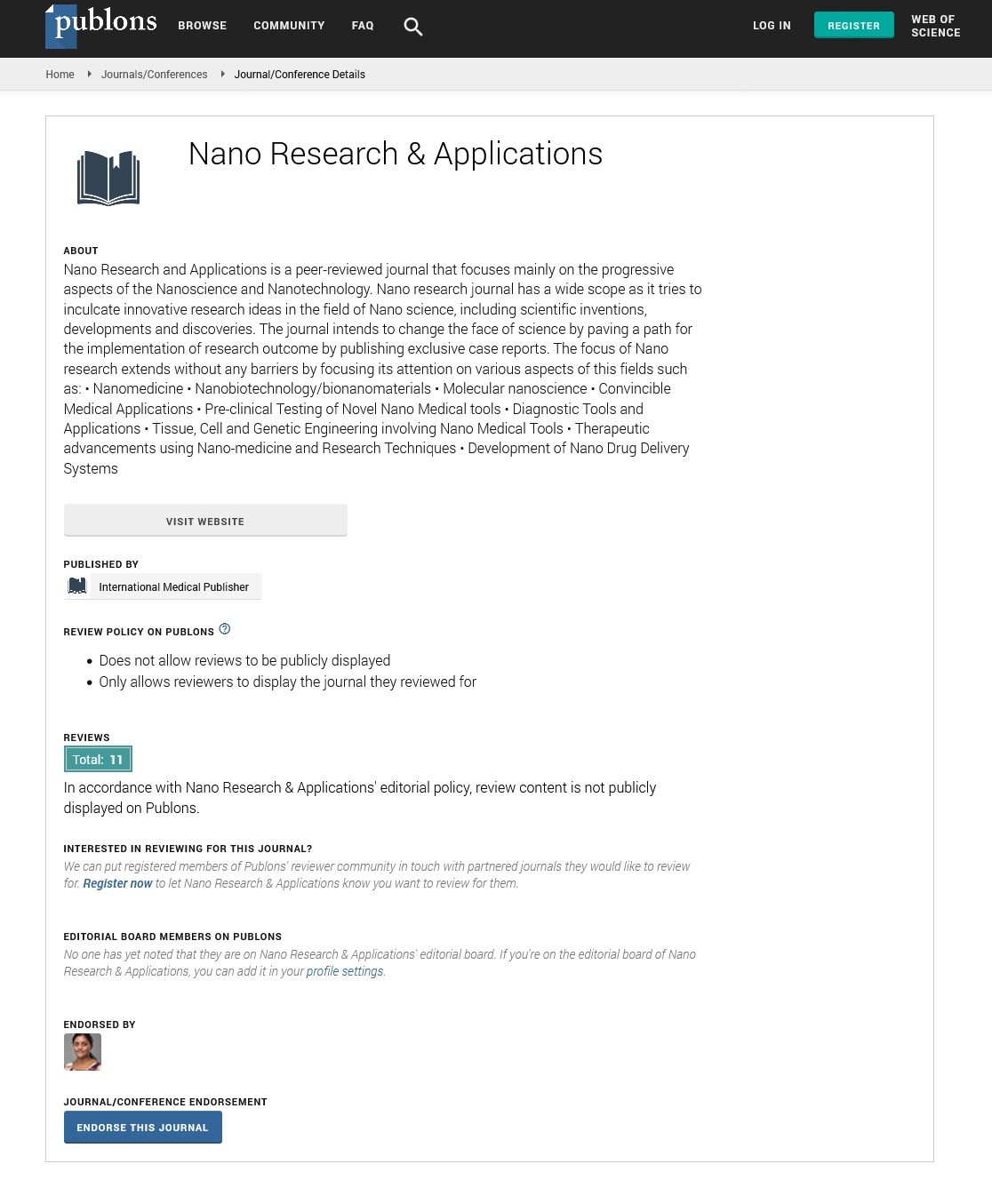ISSN : 2471-9838
Nano Research & Applications
Optimizing transfection of primary human umbilical vein endothelial cells using facial amphipathic deoxycholic acid conjugated polyethyleneimine
Joint Event on 25th Nano Congress for Future Advancements & 12th Edition of International Conference on Nanopharmaceutics and Advanced Drug Delivery
August 16-18, 2018 | Dublin, Ireland
Fatemeh Radmanesh, Hamid Sadeghi Abandansari, Sara Rajabi, Mahdi Karimi, Bahram Kazemi Demneh and Hossein Baharvand
Royan Institute for Stem Cell Biology and Technology - ACECR, Iran Shahid Beheshti University of Medical Sciences, Iran Iran University of Medical Sciences, Iran
Posters & Accepted Abstracts: Nano Res Appl
DOI: 10.21767/2471-9838-C3-015
Abstract
Introduction: Currently, RNA interference (RNAi) based gene therapy has been investigated for treating various disease conditions. However, successful application of RNAi including siRNA or miRNA has been limited by several factors in vitro and in vivo. To overcome these challenges, various non-viral carriers have been developing for efficient RNAi-mediated gene silencing. However, it is necessary to improve the efficacy of these non-viral strategies to achieve desired therapeutic effect. In this study, we carried out synthesis, characterization, and optimization of a polymeric conjugate based on low molecular weight polyethylenimine which was modified by high membrane permeable deoxycholic acid conjugated polyethylenimine (DA PEI) for efficient delivery of RNAi-based therapeutics into primary human umbilical vein endothelial cells (HUVECs). Methodology: Herein, DA-PEI conjugate was synthesized based on DCC/NHS chemistry at various DA to PEI molar ratios of 2 to 4 and used for delivery of a fluorescent labeled siRNA into HUVECs. Conjugates were characterized for chemical structure, size, and cell cytotoxicity. The effect of various parameters including DA/PEI molar ratio, polymer/siRNA weight ratio, and different buffer solutions was investigated on transfection efficacy of conjugates. Results: DA was conjugated to the terminal amine groups of the PEI 1.8 via amide bonds. The polyplexes had smaller sizes (about 130~150 nm) than the parent PEI 1.8 at different weight ratios. MTS assay revealed that the conjugates were non-toxic at polymer concentrations used in transfection experiments. The higher intracellular uptake and transfection efficiency were achieved by the conjugates synthesized in DA/PEI molar ratio of 3 or 4, polymer/siRNA weight ratio of 5 when they were prepared in salty buffers. Conclusions: These results suggest that the DA-PEI 1.8 conjugate can be applied as a promising candidate to enhance delivery of RNAi therapeutics into primary endothelial cells under the optimized transfection conditions. Recent Publications 1. Sepantafar M et al. (2017) Engineered hydrogels in cancer therapy and diagnosis. Trends in Biotechnology. 35(11):1074-1087. 2. Karimi M et al. (2016) Smart micro/nanoparticles in stimulus-responsive drug/gene delivery systems. Chemical Society Reviews. 45(5):1457-1501. 3. Karimi M et al. (2016) pH├ó┬?┬Ésensitive stimulus├ó┬?┬Éresponsive nanocarriers for targeted delivery of therapeutic agents. Wiley Interdisciplinary Reviews: Nanomedicine and Nanobiotechnology. 8(5):696-716. 4. Karimi M et al. (2013) The novel albumin chitosan core–shell nanoparticles for gene delivery: preparation, optimization and cell uptake investigation. Journal of Nanoparticle Research. 15(4):1651. 5. Karimi M et al. (2013) Evaluation of chitosan-tripolyphosphate nanoparticles as a p-shRNA delivery vector: formulation, optimization and cellular uptake study. Journal of Nanopharmaceutics and Drug Delivery. 1(3):266-278.
Biography
Fatemeh Radmanesh pursued BSc Biotechnology and MSc Microbial Biotechnology from University of Isfahan, Iran. She is currently a PhD student of Medical Biotechnology at Shahid Beheshti University of Medical Sciences. She is a Member of Royan Cardiovascular and Cell Engineering Group. She is interested in nanoparticulate delivery strategies, especially for RNAi-based therapeutics delivery. She joined Royan Institute in 2015 and pursued PhD thesis on using polymeric nanoparticles to deliver RNAi therapeutics.
E-mail: rad.biotech89@gmail.com
Google Scholar citation report
Citations : 387
Nano Research & Applications received 387 citations as per Google Scholar report
Nano Research & Applications peer review process verified at publons
Abstracted/Indexed in
- Google Scholar
- China National Knowledge Infrastructure (CNKI)
- Directory of Research Journal Indexing (DRJI)
- WorldCat
- Publons
- Secret Search Engine Labs
- Euro Pub
Open Access Journals
- Aquaculture & Veterinary Science
- Chemistry & Chemical Sciences
- Clinical Sciences
- Engineering
- General Science
- Genetics & Molecular Biology
- Health Care & Nursing
- Immunology & Microbiology
- Materials Science
- Mathematics & Physics
- Medical Sciences
- Neurology & Psychiatry
- Oncology & Cancer Science
- Pharmaceutical Sciences
